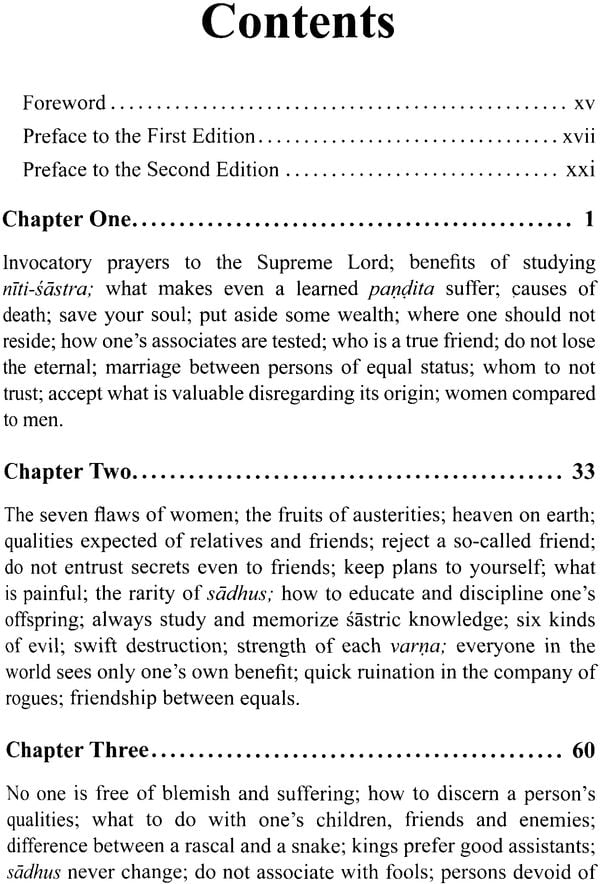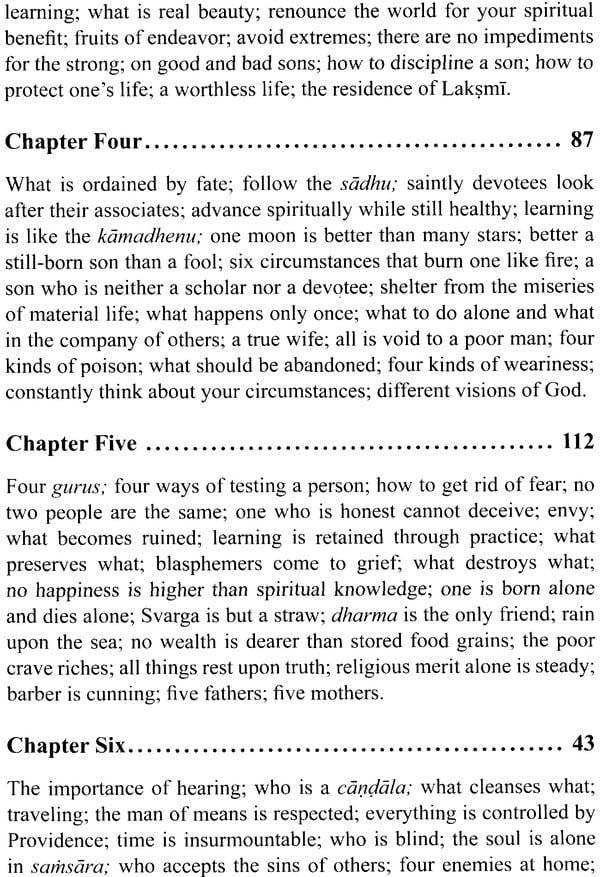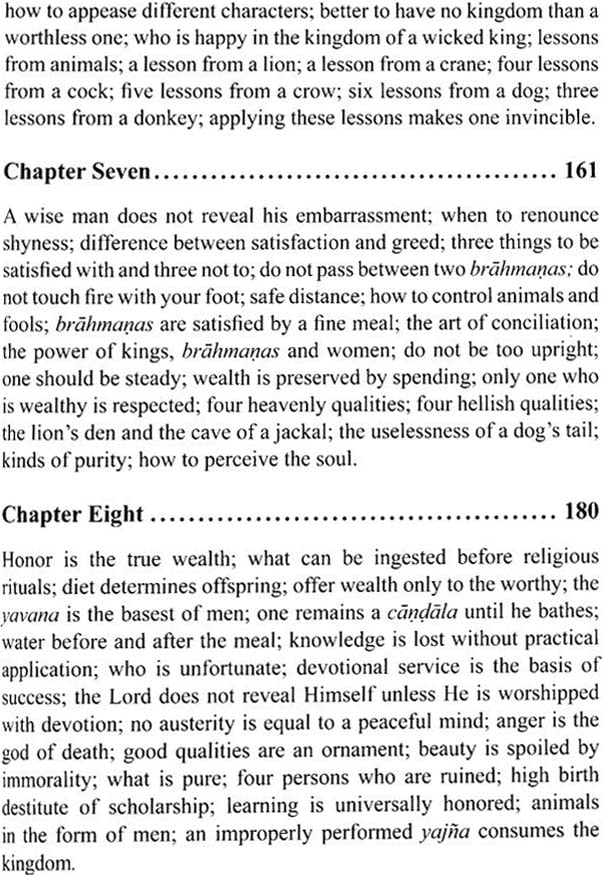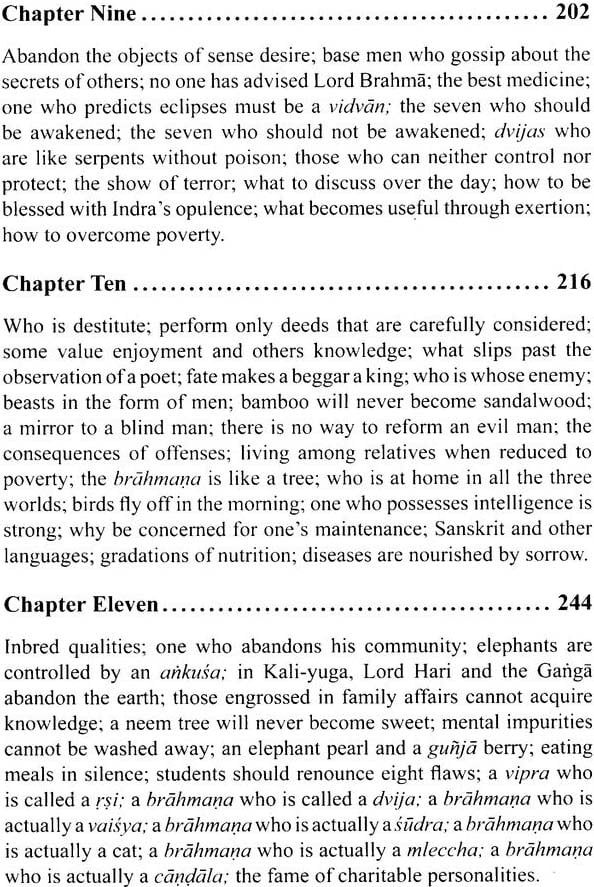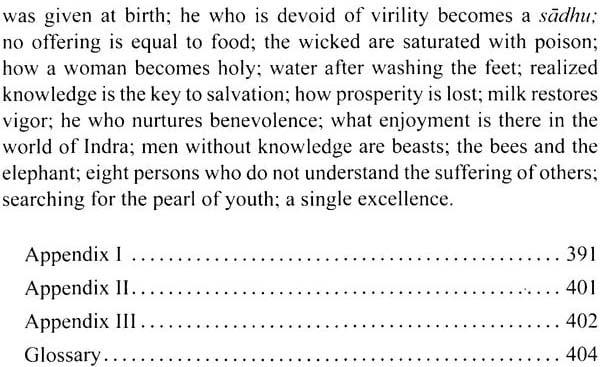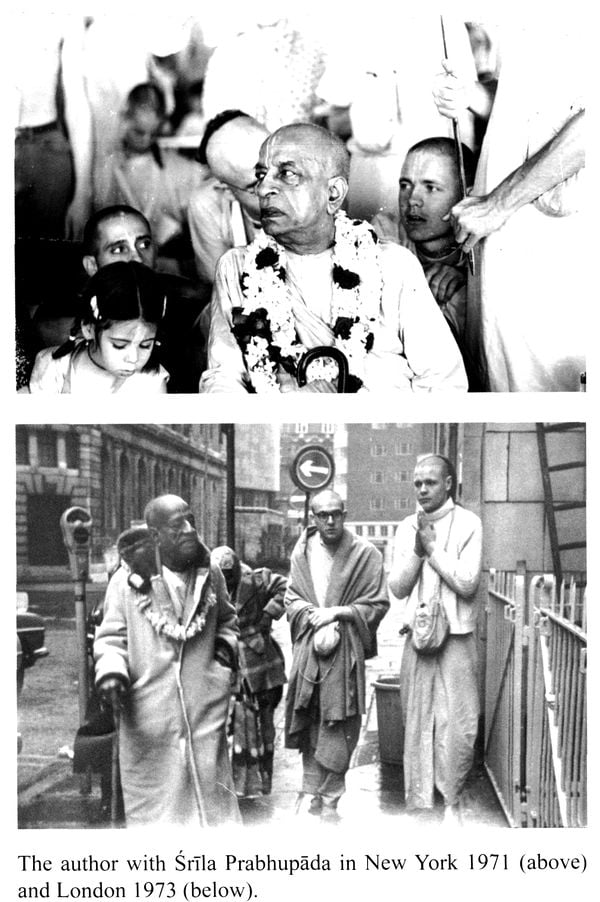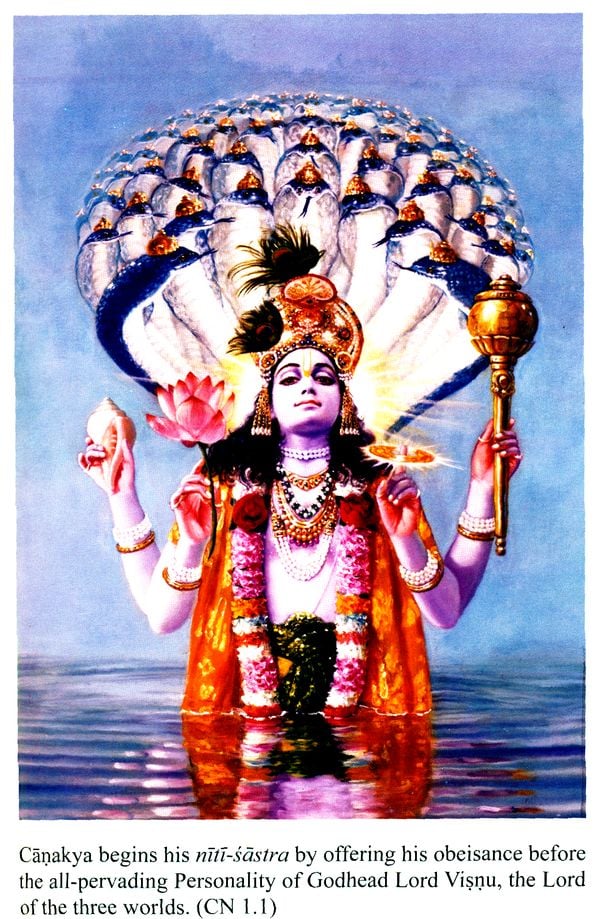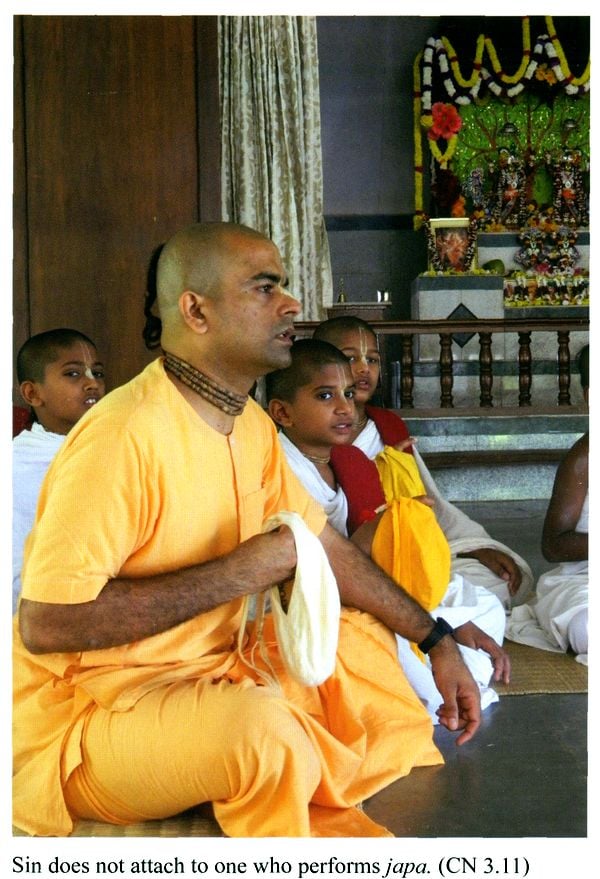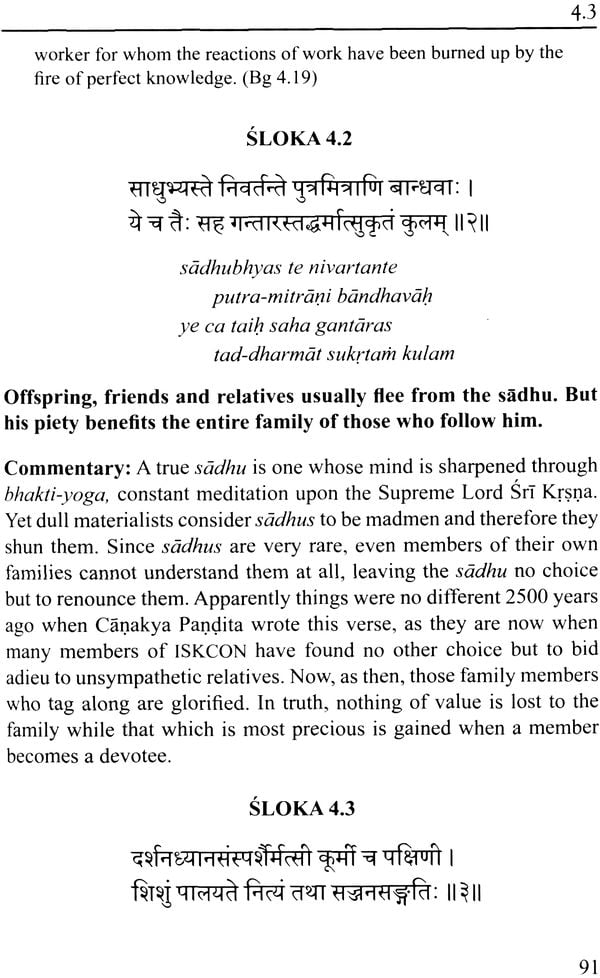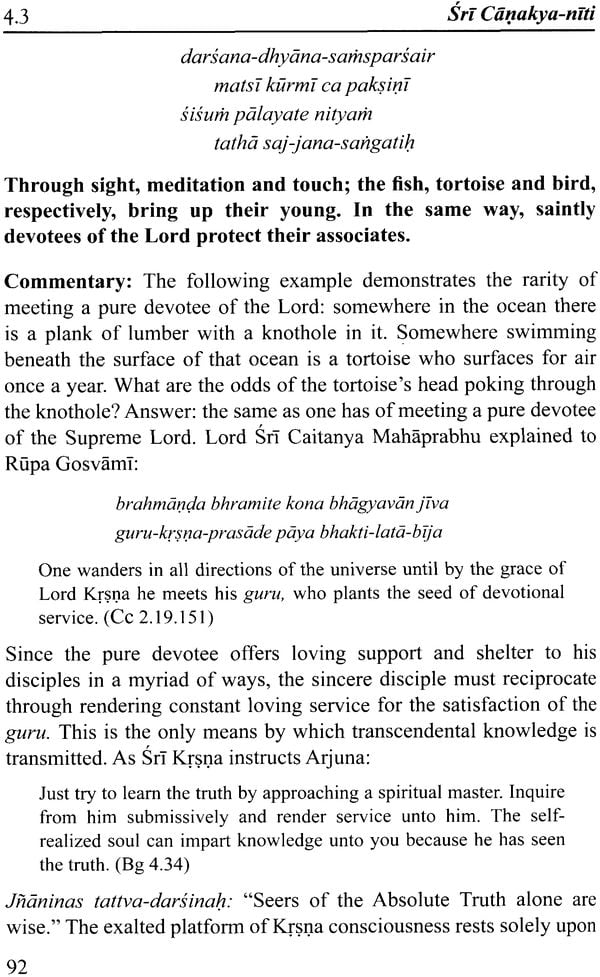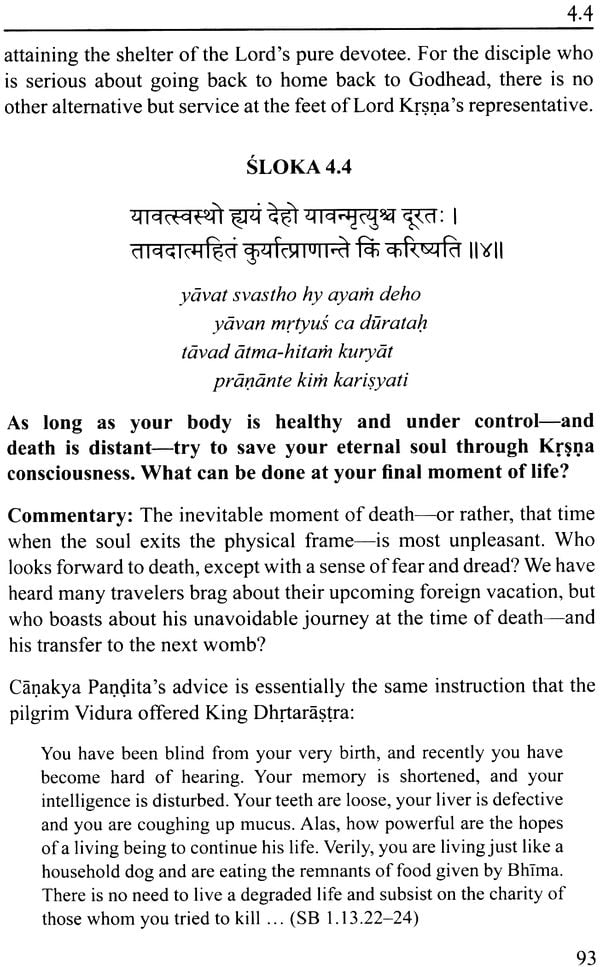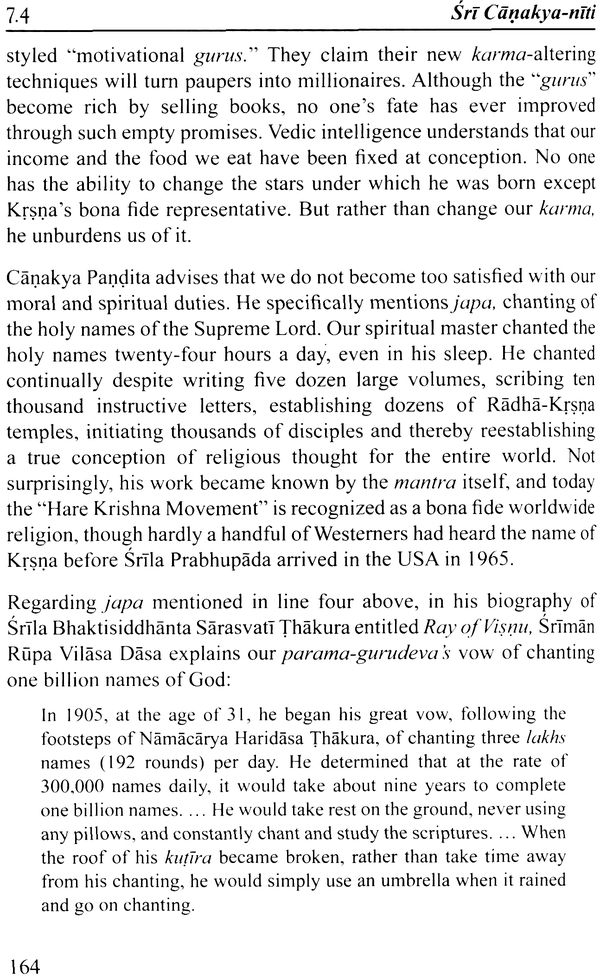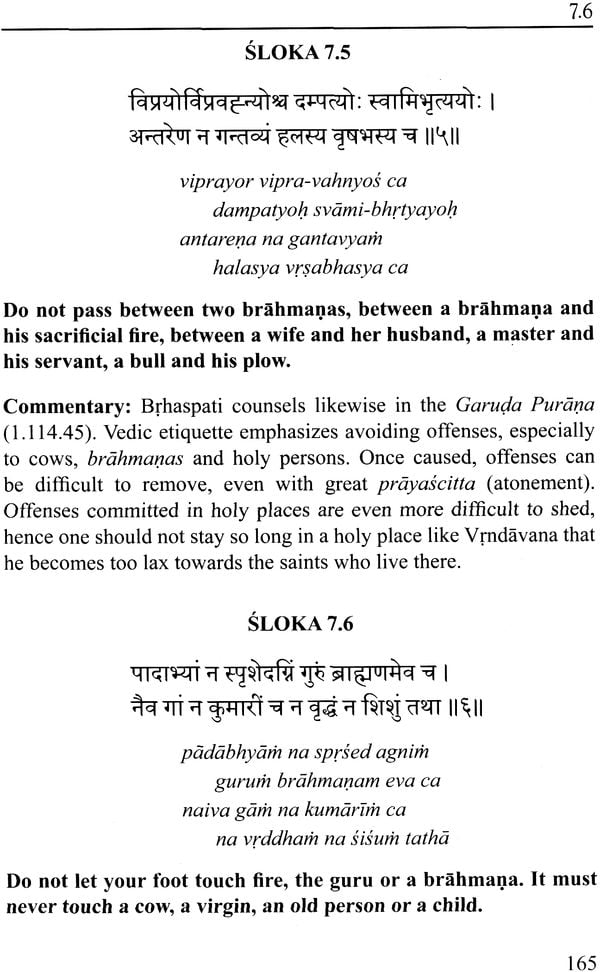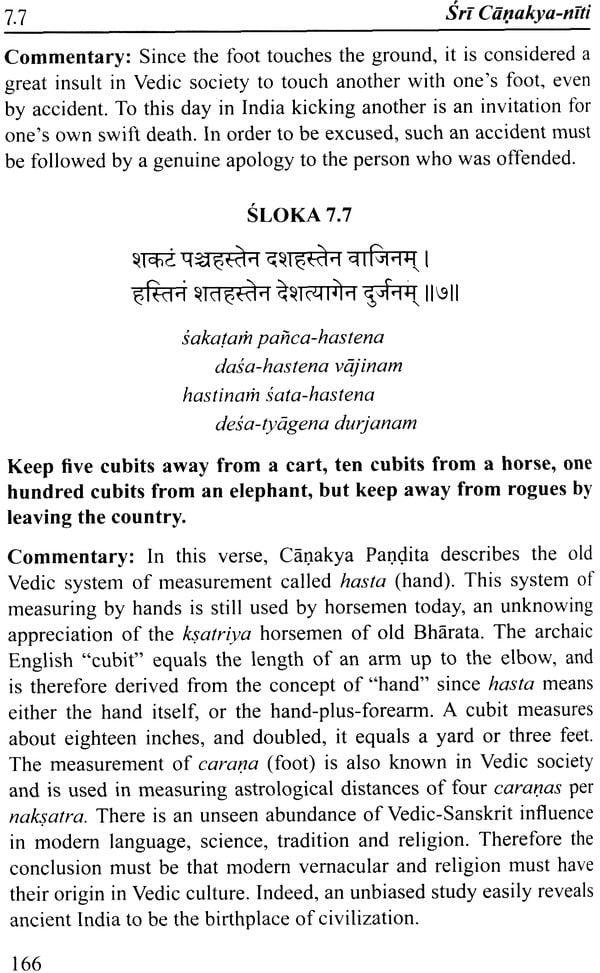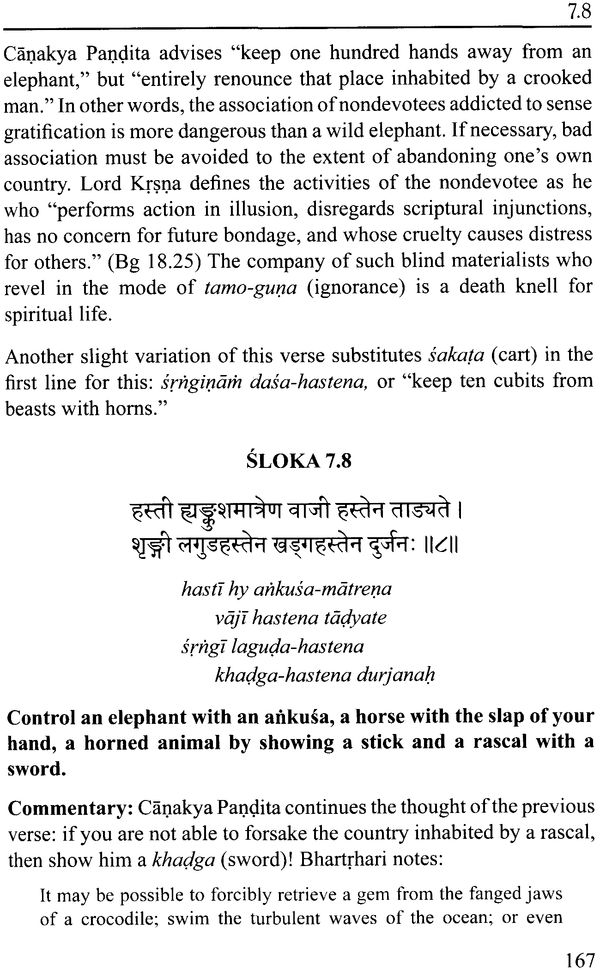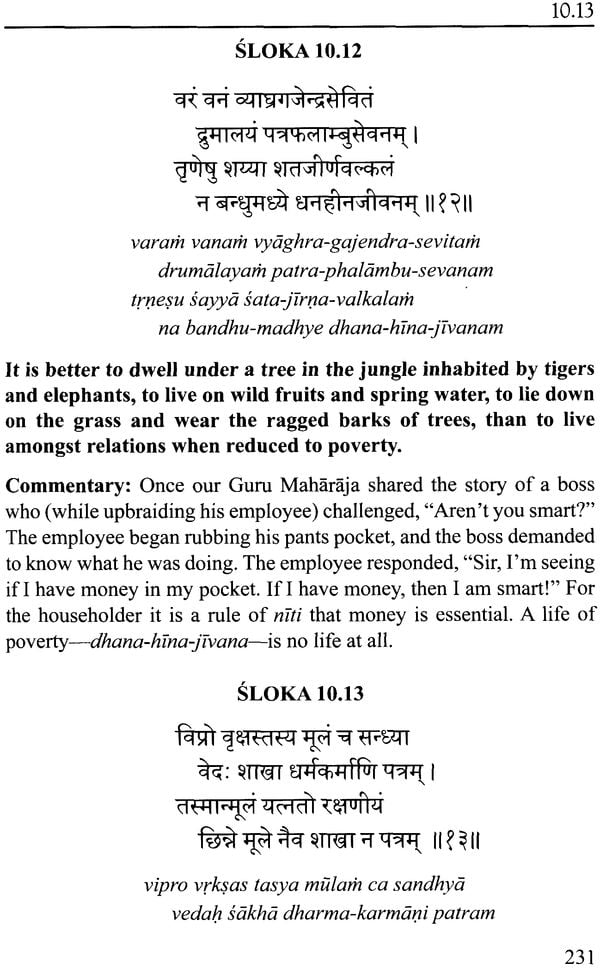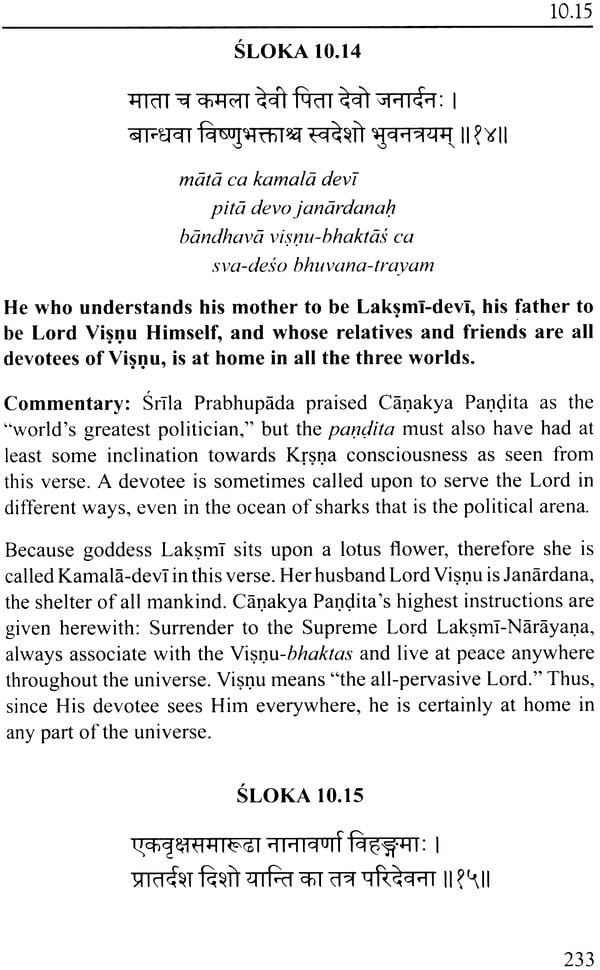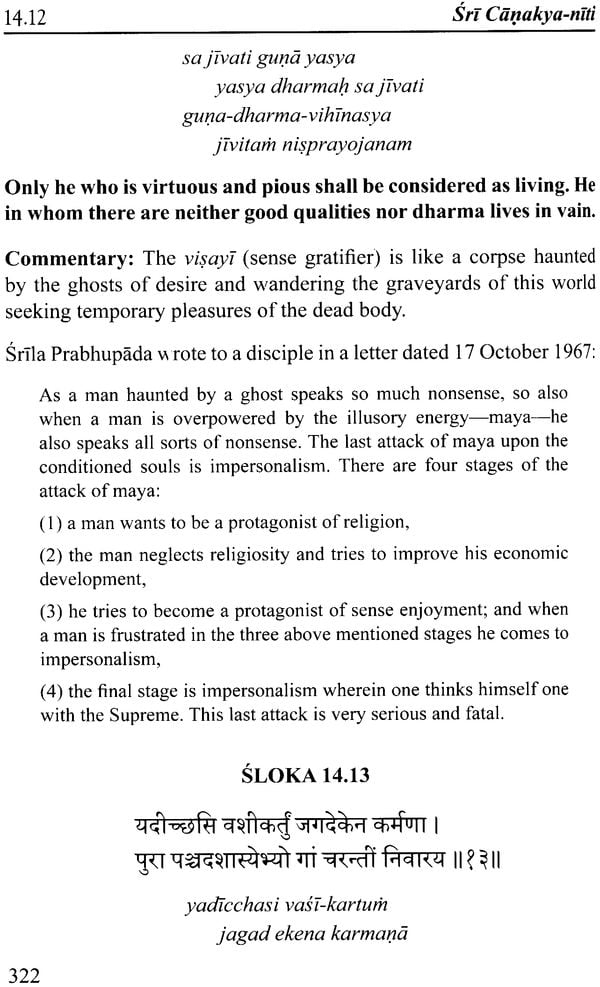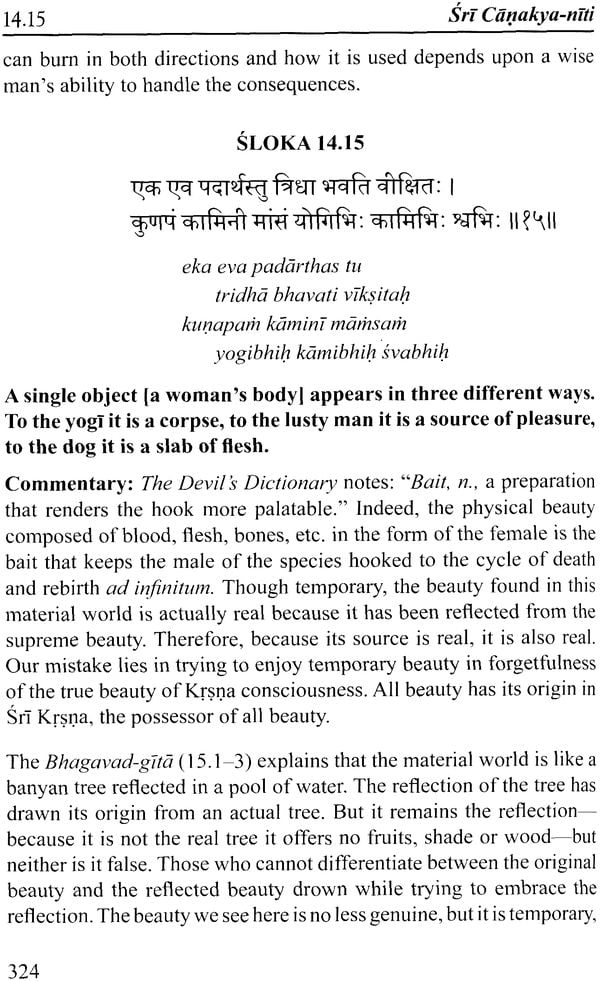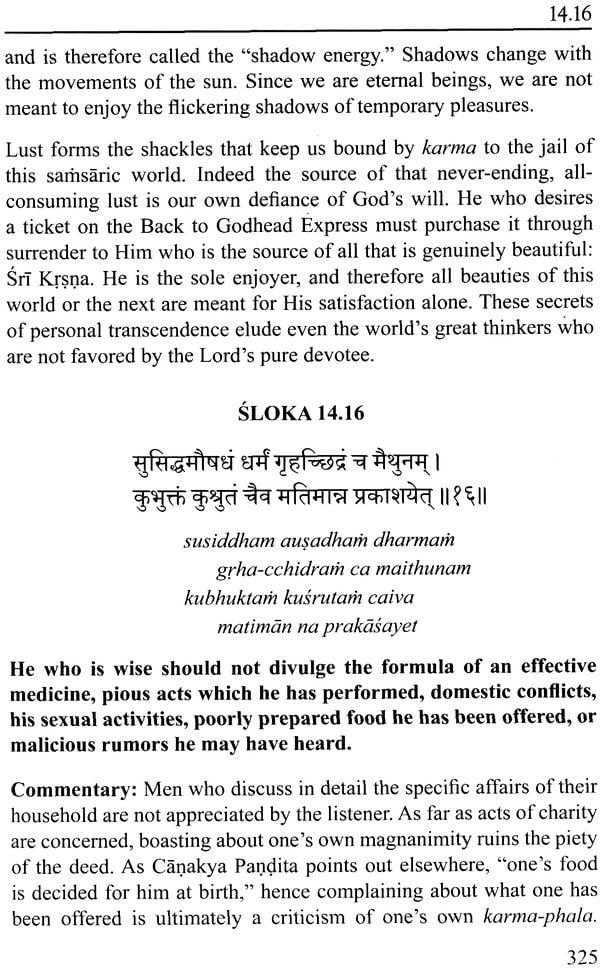
Sri Canakya Niti (Ancient Sense for Modern Success)
Book Specification
| Item Code: | NAN454 |
| Author: | Patita Pavana Dasa Adhikari |
| Publisher: | Bhakti Vikas Trust |
| Language: | Sanskrit Text With Transliteration and English Translation |
| Edition: | 2013 |
| ISBN: | 9789382109259 |
| Pages: | 452 (8 Color Illustrations) |
| Cover: | Hardcover |
| Other Details | 8.5 inch X 5.5 inch |
| Weight | 550 gm |
Book Description
Though he was an impoverish brahmana scholar, Canakya Pandita created one of the largest empires in ancient times. In the same era that Buddha walked the earth, this indomitable sage united many disjointed kingdoms from modern day Bihar to Iran using only his wit as his weapon. He is celebrated as the greatest king maker in history. During the days of Britain’s East India Company, English officers were required to study Sri Canakya-niti if they hoped to be successful in India.
Now that same wisdom commented upon by the world’s greatest authority on Canakya, His Divine Grace A.C. Bhaktivedanta Swami Prabhupada, is available for the first time in one volume. Canakya’s niti-his ancient sense for modern success-is presented with the original Sanskrit Latin transliterations, lucid translations, plus the commentaries of Srila Prabhupada and much more. Practically every recorded statement that His Divine ever made about great Canakya can be found here in this definitive edition. For the modern reader, the wisdom of Canakya is nothing less than the key to a life that in every way successful, happy and fulfilled.
I first met Patita Pavana Prabhu in 1975, at the intergalactically famous temple of Sri Sri Radh-Londonisvara. I was a raw recruit; he, a grand old veteran of seven years. He found in me a ready audience for his large repertoire of stories about Srila Prabhupada and about India, and for his many takedowns of Mayavada that he had imbibed from Srila Prabhupada and that he willingly imparted to me. As ordained by fate, Prabhupada and that he willingly imparted to me.As ordained by fate,our ways soon parted, until about two years ago when we again met (on the internet-where else?). We found ourselves to be still united on the eternal platform of service to Parbhupada and his mission. In the interim, we had both written and published books. Some thirty years before, I had read the English edition of Sri Canakya-nit which he had produced, and when I learned that he was planning to issue an expanded version, I suggested that he have it edited by capable disciple Kisora Dasa. After Kisora’s work, I further reviewed it, and the final result is what you now hold in your hands.
Canakya was both an accomplished scholar and a practical man of this world. While offering realistic directions for navigating the complexities of life, he yet surpasses the sound advice offered in the manywisdom traditions of the world. Due to his being firmly grounded in Vedic culture, Canakya’s realism extends beyond the blip of our present temporary situation and points us toward our eternal spiritual existence, clear knowledge of which is the distinguishing feature of Vedic culture. Unlike his Artha-sastra, which is advice specically meant for rulers, Canakya’s Niti-sastra, which is advice specifically meant for rulers, Canakya’s Niti-sastra is more suitable for those brahmanas like himself whose aim is to instruct the rulers of society. Thus Sri Canakya-niti is most appropriate for ISKCON brahmanas, for whom Srila Prabhupada envisaged such a role.
Although Canakya was not a Vaisnava, his guidelines can be valuable for Vaisnavas, asratifies in their having been often quoted by no less a Vaisnava than His Divine Grace A.C. Bhaktivedanta Swami Prabhupada. As a faithful disciple of Srila Prabhupada, Patita Pavana Dasa has given a distinctly Vaisnava perspective on Canakya’s teachings, and has also, as did Srila Prabhupada, upheld Canakya’s statements concerning Vedic cultural norms (for instance, those concerning the role of women as dutiful and subordinate wives), not withstanding their unpopularity in today’s purportedly egalitarian ethos. Patita Pavana Dasa has added to all this this several of his own insights and perceptions, gleaned from his lifelong practice of krsna consciousness, and the end result is a colorful compendium of behavioral advice, penned for ancient civilization and presented herein as relevant for the more thoughtful among modern humankind.
Shri Chanakya Pandit, also known as Kautilya, or sometimes as Vishnugupta, attained lasting fame some 2300 years ago for two reasons: (1.) his Sanskrit writings on polity, and (2.) the practical and effective counsel he gave to king Chandragupta Maurya who conquered most of India under his guidance. Of his writings, Artha Shastra is a well-known work and many editions have come out in English. As implied by its title, Artha Shastra is a scripture of economic development for kings and court pandits. Some of its topics are: the duties of the king, qualifications of ministers, formation of villages, tax collection, proper punishments for offenders, the training of spies, declaring war and making peace and protection of the citizens.
Chanakya’s NitiShastra is this great court Pandit’s most famous work. Niti is variously translated as “the science of morality,” “common sense,” “expediency” or “ethics.” Hence Shri Chanakya Hiti Shastra contains sagacious wisdom that may be applied to daily affairs with profit. In other words, Chanakya herewith teaches us how to be happy in mundane life. If the devotee can improve his execution of devotional service unto the Supreme Personality of Godhead Lord Shri Krishna by taking practical counsel from Chanakya Pandit, then the value of these proverbs will be increased. Past acharyas have said that just as a woman who has a lover her own husband with even greater attention, similarly, the devotee, though always absorbed in thoughts of the Lord, carries out his so-called mundane activities with even greater expertise.
Although many of Chanakya’s shlokas or aphorisms were borrowed from earlier works, Chanakya’s name reverberates through history for his ability to practically apply shastric wisdom. It can be said that Chanakya’s uncanny proficiency to outguess the enemy at every step and to guide his king to resounding victory has caused his name to stand out as one of history’s most profound political thinkers. Today in India’s capital city of Delhi, the diplomatic housing enclave bears his name: Chanakya Puri.
The British scholar Dr. J.F. Fleet has written, “Kautilya (Chanakya) is renowned not only as a king-maker, but also for being the greatest Indian exponent of the art of government; the duty of Kings, ministers and officials; and the methods of diplomacy.” We are told that the East India Company strongly urged its officers to study the writings of Chanakya pandit if they hoped at all to succeed in ruling India.
In his Artha Shastra, Chanakya Pandit identifies himself as being responsible for the overthrow of the corrupt Nanda dynasty of Magadha (present day Bihar State in Northern India). A brief account of how he accomplished this is herewith given:
About 2300 years ago, the Greek conqueror Alexander the Great invaded the Indian sub-continent. His offensive upon the land’s patchwork of small Vedic empires proved to be highly successful due to the disunity of the petty rulers. It was Chanakya Pandit who, feeling deeply distressed at heart, searched for and discovered a highly qualified leader in the person of Chandragupta Maurya. Although a mere dasi-putra, that is, a son of a maidservant by the Magadha King Nanda, Chandragupta was highly intelligent, courageous, and physically powerful. Chanakya cared little that by birth he should not have dared to approach the throne. A man of acute discretion, Chanakya desired that only a ruler of extraordinary capabilities be raised to the exalted post of king of Magadha so that offensive launched by the Yavanas (Greeks) could be repressed.
Legend says that Chanakya had been personally offended by king Nanda, and that this powerful brahmana and vowed to keep his long shikha unknotted until he saw to the demise of the contemptuous ruler and his drunken princes. True to his oath, it was only after Chanakya Pandit engineered the swift demise for the degraded and worthless rulers of the Nanda clan that this great brahmana was able to tie up his brahminical tuft of hair. There are several versions relating to the exact way that Chanakya set about eliminating the Nandas, and it appears historians have found it difficult to separate fact from legend as regards to specific details.
After the Nanda downfall, it became easy for Chandragupta Maurya to win the support of the citizens of Magadha, who resounded warmly to their new heroic young ruler. Kings of neighboring states rallied under Chandragupta’s suzerainty, and the last of the Greeks headed by Alexander’s general Seleucus were defeated.
With the dual obstacles of the Nandas and Alexander’s troops out of the way, Chanakya Pandit used every political device and court intrigue to unite the greater portion of the Indian sub-continent. Under the ministry of Chanakya, Chandragupta Maurya conquered all the lands up to Persia in the Northwest and down to the extremities of present-day Karnataka or Mysore in the south. It was by his wits alone that this skinny and ill-clad brahmana directed the formation of the greatest Indian empire ever before in history, since the beginning of Kali Yuga. Thus the indigenous Vedic culture and civilization of the sacred land of Bharata was protected and its spiritual practices remained unhampered.
Although the great pandits of niti-including Brihaspati, Shukracharya, Bhartrihari and Vishnusharma-have echoed many of these instructions in their own celebrated works; it is undoubtedly the way that Chanakya applied his teachings of niti that has made him stand out as a significant historical figure. The pandit teaches us that lofty ideals can become certain reality if we diligently work towards achieving our goals in a determined and practical manner, keeping in mind the instructions of the preceptor.
Dr. R. Shamashastry, the English translator of Kautilya’s Artha Shastra, quotes a prediction from the Vishnu Purana, fourth canto, twenty-fourth chapter, regarding the appearance of Chanakya Pandit, Incidentally, Vyasa seribed this prediction 2700 years before this political heavyweight and man of destiny was to appear. “(First) Mahapadma, then his sons-only nine in number-will be the lords of the earth for hundred years. A brahmana named Kautilya will slay these Nandas. On their death, the Mauryas will enjoy the earth. Kautilya himself will install Chandragupta on the throne. His son will be Bindusars and his son will be Ashokavardhana.” Simmilar prophecies are also repeated in the Bhagavata, Vayu and Matsya Puranas.
In presenting this work, I have used as references two old English versions of Chanakya Niti-shastra published at the close of the Eighteenth Century.’ I have also consulted another version, an unedited manuscript from the ISKCON Center in Vrindavana which contained both an English translation and Latinized Sanskrit transliteration. It was, however, the learned Vaishnava Pandit and scholar of Sanskrit Shri. V. Badarayana Murthy of the Udipi Madhva School who helped me see the depth and import of these verses from the original Devanagari script.
Ihave been told that our blessed spiritual master His Divine Grace A.C. Bhaktivedanta Swami Prabhupada had expressed a desire that Shri Chanakya Niti Shastra be properly translated into English. It is hoped that our present rendering will be at least useful if not instructive to the reader. Let us now examine a few words on the science of niti, or common sense, from the pen of Shrila Bhaktivinode Thakur, the great nineteenth century devotee-pioneer of the worldwide propagation of Lord Chaitanya’s divine message. Taking the “common sense’ right up to the highest level, Shri Bhaktivinode has written:
Man’s glory in common sense,
Dictating him the grace, That man is made to live and love,
The beauteous heaven’s embrace.
In other words, the real goal of niti, indeed the goal of life, is to realize one’s other words, the real goal of niti, indeed the goal of life, is to realize one’s eternal position of Krishna consciousness. The Bhagavad Gita confirms the Thakur’s view in the final line of its last shloka: dhruva nitir matir mama. The full translation of that verse runs, “(Sanjaya said) Wherever there is Krishna, the Master of all mystics, and wherever there is Arjuna, the supreme archer, there will certainly be my opinion.”
Canakya Pandita was relatively unknown outside of India until Srila Prabhupada introduced the world to this master politician. Our first edition of Sri Canakya-niti-sastra sold out in 1981, but since then the internet has made that edition the widely read version in English. Therefore we are hopeful that this updated version with the added benefit of commentaries, transliterated Sanskrit, cross-references to other source in niti-sastra and most importantly Srila Prabhupada’s insight into key verses will cause this second edition to be widely welcomed. That Srila Prabhupada wanted the members of his ISKCON to have access to Canakya Pandita’s slokas is seen in a letter His Divine Grace wrote to Dayananda Prabhu in April of 1974 in which he stated, “As for Canakya-sloka, I think the best thing is if I translate it myself and send it to you for printing, rather than wait…”
In the first verse Canakya Pandita himself explains that these slokas have been raked from other sources. He says: “I now recite maxims selected from various sastras pertaining to political ethics.” This edition annotates for the first time the verses from the Garuda Purana edition annotates for the first time the verses from the Garuda Purana and elsewhere that are the likely origins of many of these parables for success.
As far our own personal qualifications for presenting Sri Canakya-niti, I confess that I have none. Srila Prabhupada has told me, “I am simply praying to Krsna to give you intelligence.” He clarified this point a few years later when he explained to me in no uncertain terms that I am the greatest fool and rascal and not even deserve to live. Aside from that, he told me to deliver everyone in the universe. Therefore, since we are without qualifications, we have simply let the verses and Srila Prabhupada’s insight into them speak for themselves.
My sincere thanks to my respected Godbrother his Holiness Srila Bhakti Vikasa Maharaja for kindly arranging for the printing of this volume and for his valuable insight into the text. His disciples Sriman Kisora Dasa Adhikari and Srimati Ananta-sarovara Dasi, a husband-wife team, have brought the work to a higher focus through their expertise of Sanskrit editing, proofreading insight and generally bringing the text up to the scholastic standard of the Bhaktivedanta Book Trust. I would also like to thank them for composing the table of contents and the glossary. Another proficient disciple of Maharaja, Sriman Vrndavana Candra Prabhu, capably handled the final formatting. Thanks also to my companion and better half at Mithuna Twiins Astrological Services Srimati Abhaya Mudra Dasi for her suggestions, art work, formatting and cover design. It is our deep regret that our dear mentor in this effort Pandita Sri V. Badarayana Murthy has departed this planet and will not see this edition. He was a faithful servant of both his Madhva Vaisnava sampradaya and of Srila Prabhupada, and he was like our real father. We pray that he has reached the supreme destination at Sri Krsna’s lotus feet.
Srila Prabhupada teaches, “In explaining the glories of the Lord, inexperienced men may compose poetry with many faults, but because it contains glorification of the Lord, inexperienced men may compose poetry with many faults, but because it contains glorification of the Lord, great personalities read it, hear it and chant it.” (SB 1.5.11) And, “Despite its minute literary discrepancies, one must study poetry on the merit of its subject matter. According to Vaisnava philosophy, any literature that glorifies the Lord, whether properly written or not, is first class. There need be no other considerations.” (Sri Caitanya-caritamrta, 1.16.102, presentation.
